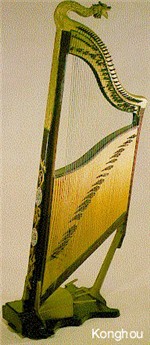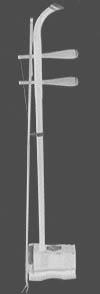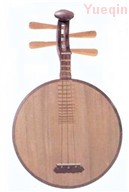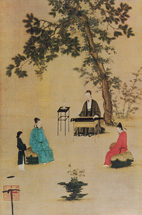SITAR By Chia Wei Yeh |
Wednesday 23 July 2014
Indian Music
Instruments In Indian Music
Malay Music
Traditional Malay music and performing arts appear to have originated in the Kelantan-Pattani region with influences from India, China, Thailand and Indonesia. The music is based around percussion instruments, the most important of which is the gendang (drum). There are at least 14 types of traditional drums. Drums and other traditional percussion instruments are often made from natural materials. Besides drums, other percussion instruments (some made of shells) include: the rebab (a bowed string instrument), the serunai (a double-reed oboe-like instrument), the seruling (flute), and trumpets. Music is traditionally used for storytelling, celebrating life-cycle events, and times like harvest. It was once used as a form of long-distance communication.
In East Malaysia, gong-based musical ensemble such as agung and kulintang are commonly used in ceremonies such as funerals and weddings. These ensembles are also common in neighbouring regions such as in the southern Philippines, Kalimantan in Indonesia and Brunei.
The Malays of Kelantan and Terengganu are culturally linked to peoples from the South China Sea area, and are quite different from the West Coast of Malaya. The martial art of silat Melayu developed in the Malay peninsula since the beginning of common era also popular in Malaysia, while essentially still important as a branch of the self-defence form. Similar to t'ai chi, though of independent origin, it is a mix of martial arts, dance and music typically accompanied by gongs, drums and Indian oboes.
The natives of the Malay Peninsula played in small ensembles called kertok, which performed swift and rhythmic xylophone music. This may have led to the development of dikir barat. In recent years, the Malaysian government has promoted this Kelantanese music form as a national cultural icon.
Johor art performances such as Zapin and Hamdolok as well as musical instruments including Gambus and Samrah have apparent Arab and Persian influences.Arabic-derived zapin music and dance is popular throughout Malaysia, and is usually accompanied by a gambus and some drums. Ghazals from Arabia are popular in the markets and malls of Kuala Lumpur and Johor, and stars like Kamariah Noor are very successful. In Malacca, ronggeng is the dominant form of folk music. It played with a violin, drums, button accordion and a gong instrument. Another style, Dondang Sayang is slow and intense; it mixes influences from China, India, Arabia, and Portugal with traditional elements.
[Source: wikipedia]
Instruments of Malay Traditional Music
 |
Gong
[Images found through Google Image]
Prepared by: Wong Wei Jun
Monday 21 July 2014
Chinese tradisional instrument and music
I. The Plucked String Instruments
The Lute family


The Lute family
 Pipa (
Pipa (
 ) - four-stringed lute with 30 frets and pear-shaped body. The instrumentalist holds the pipa upright and play with five small plectra attached to each finger of the right hand. The pipa history can be dated back at least 2000 years and developed from pentatonic to full scales. This instrument has extremely wide dynamic range and remarkable expressive power.
) - four-stringed lute with 30 frets and pear-shaped body. The instrumentalist holds the pipa upright and play with five small plectra attached to each finger of the right hand. The pipa history can be dated back at least 2000 years and developed from pentatonic to full scales. This instrument has extremely wide dynamic range and remarkable expressive power. 
- Liuqin (

 ) -a smaller version of pipa with four strings, which sound similar to mandolin. Liuqin is played with a piece of spectrum, and is used to be accompany instrument for folk songs and local opera. However, in recent decades, Composer Wang Huiran made great contribution to its making and composed many pieces such that the Liuqin also becomes a soloist instrument.
) -a smaller version of pipa with four strings, which sound similar to mandolin. Liuqin is played with a piece of spectrum, and is used to be accompany instrument for folk songs and local opera. However, in recent decades, Composer Wang Huiran made great contribution to its making and composed many pieces such that the Liuqin also becomes a soloist instrument.

- Sanxian (

 )- A long necked lute with three strings without frets. In Chinese, "san" and "xian" stands for " "three" and "strings", respectively. The sound-body is made of round wooden box covered with snake skin, just like erhu. A piece of plectrum is used to play the instrument. This instrument is often used for accompanying folk songs and local opera. The sanxian is most popular in the north.
)- A long necked lute with three strings without frets. In Chinese, "san" and "xian" stands for " "three" and "strings", respectively. The sound-body is made of round wooden box covered with snake skin, just like erhu. A piece of plectrum is used to play the instrument. This instrument is often used for accompanying folk songs and local opera. The sanxian is most popular in the north. 

- Ruan (
 )- commonly referred to as "Chinese guitar", is an ancient four-stringed moon-shaped lute with long and straight neck and various number of frets, dated back at least to Qin Daynasty (around 200 BC). Ruan is used to
)- commonly referred to as "Chinese guitar", is an ancient four-stringed moon-shaped lute with long and straight neck and various number of frets, dated back at least to Qin Daynasty (around 200 BC). Ruan is used to  be called "p'i-p'a" (pipa) or qin-pipa. Since the introduction of the oud-like instrument through the "silk-road" around 5th century, a new type of "pipa" with pear-shaped body and bent neck has been gradually developed into the present form since the Tang Dynasty (618-917AD), and the name pipa, which used to be a generic term for all pluck string lutes, has been specifically given to this newly-developed version, whereas the old form of pipa with straight-neck and round body got the name "Ruan", after the name of the grand master of this instrument, Ruan Xian who was one of the seven great scholars known as "Seven Sages of the Bamboo Grove" in Chinese history of the 3rd century (the Six Dynasties). They were truely good friends and did spend much time together in arts and wine during one of the darkest periods in Chinese history.
be called "p'i-p'a" (pipa) or qin-pipa. Since the introduction of the oud-like instrument through the "silk-road" around 5th century, a new type of "pipa" with pear-shaped body and bent neck has been gradually developed into the present form since the Tang Dynasty (618-917AD), and the name pipa, which used to be a generic term for all pluck string lutes, has been specifically given to this newly-developed version, whereas the old form of pipa with straight-neck and round body got the name "Ruan", after the name of the grand master of this instrument, Ruan Xian who was one of the seven great scholars known as "Seven Sages of the Bamboo Grove" in Chinese history of the 3rd century (the Six Dynasties). They were truely good friends and did spend much time together in arts and wine during one of the darkest periods in Chinese history.  Ruan Xian and Ji Kang (master of guqin, Chinese 7-stringed zither), are most famous for their musical achievements and the life as true artists. The Ruan is mostly used for Peking opera, and now also in modern Chinese orchestra. There are a family of ruan of various size including "Zhong Ruan" (middle Ruan) and "Da Ruan" (large Ruan) used in the same sense as viola and cello in western orchestra.
Ruan Xian and Ji Kang (master of guqin, Chinese 7-stringed zither), are most famous for their musical achievements and the life as true artists. The Ruan is mostly used for Peking opera, and now also in modern Chinese orchestra. There are a family of ruan of various size including "Zhong Ruan" (middle Ruan) and "Da Ruan" (large Ruan) used in the same sense as viola and cello in western orchestra.

- Yueqin (

 )- moon-shaped lute with shorter neck and four strings, played with a spectrum, used for accompanying local operas. "Yue" stands for "the moon" in Chinese.
)- moon-shaped lute with shorter neck and four strings, played with a spectrum, used for accompanying local operas. "Yue" stands for "the moon" in Chinese. 

- Guqin (

 ) - seven-stringed zither without bridges, the most classical
) - seven-stringed zither without bridges, the most classical  Chinese instrument with over 3000 years of history. The guqin is
Chinese instrument with over 3000 years of history. The guqin is  often referred to as the instrument of sages for the purpose of enriching the heart and elevating human spirit. Confucius (around 600 BC) was a master of this instrument. In the Imperial China's past, well-educated people of the elite society were expected to master the four arts, namely, the qin (guqin), qi (weiqi, which has somehow been known as "Go" in the West according Japanese pronuciation), shu (Calligraphy), and hua (painting). Being on top of the four traditional arts, the guqin has historically been regarded as one of the most important symbols of Chinese high culture. Unfortunately only small number of people in China could play the instrument, because classical musical education of this kind has never reached general public. Fortunately, the situation has much been improved in recent decades, there have been a growing number of guqin players both in and outside China. Since november 2003, Guqin has been registered as one of the master pieces of the Oral and Intangible Heritage of the humanity by UNESCO
often referred to as the instrument of sages for the purpose of enriching the heart and elevating human spirit. Confucius (around 600 BC) was a master of this instrument. In the Imperial China's past, well-educated people of the elite society were expected to master the four arts, namely, the qin (guqin), qi (weiqi, which has somehow been known as "Go" in the West according Japanese pronuciation), shu (Calligraphy), and hua (painting). Being on top of the four traditional arts, the guqin has historically been regarded as one of the most important symbols of Chinese high culture. Unfortunately only small number of people in China could play the instrument, because classical musical education of this kind has never reached general public. Fortunately, the situation has much been improved in recent decades, there have been a growing number of guqin players both in and outside China. Since november 2003, Guqin has been registered as one of the master pieces of the Oral and Intangible Heritage of the humanity by UNESCO 

- Zheng (
 ) or Guzheng (
) or Guzheng (
 )- Chinese zither with movable bridges and 16 - 25 strings. In the same family there are the Japanese koto, the Vietnamese dan tranh, the Koreankayagum, and the Mongolian Yagta
)- Chinese zither with movable bridges and 16 - 25 strings. In the same family there are the Japanese koto, the Vietnamese dan tranh, the Koreankayagum, and the Mongolian Yagta 


- Konghou (

 ) - One of the most ancient Chinese music instruments that appeared in written texts of the Spring and Autumn period (around 600 BC). The structure of the Konghou looks similar to the harp, however, with its bridges spanning the strings in the way similar to guzheng. There were the wo-konghou (horizontal konghou), su-konghou (vertical konghou) and phoenix-head konghou. Unfortunately not much of this ancient instrument has been preserved. The reproduction of the konghou started in the mid 50's. The structure of Today's konghou is a combination of su-konghou and wo-konghou with the shape similar to harp. The performing skill is diversified. Besides right-hand techniques, the left hand can play vibratos, glissandos, etc. The tone quality is mellow and graceful and has a typical Chinese flavour.
) - One of the most ancient Chinese music instruments that appeared in written texts of the Spring and Autumn period (around 600 BC). The structure of the Konghou looks similar to the harp, however, with its bridges spanning the strings in the way similar to guzheng. There were the wo-konghou (horizontal konghou), su-konghou (vertical konghou) and phoenix-head konghou. Unfortunately not much of this ancient instrument has been preserved. The reproduction of the konghou started in the mid 50's. The structure of Today's konghou is a combination of su-konghou and wo-konghou with the shape similar to harp. The performing skill is diversified. Besides right-hand techniques, the left hand can play vibratos, glissandos, etc. The tone quality is mellow and graceful and has a typical Chinese flavour.

- Erhu (

 )- or Er-Hu, a two-stringed fiddle, is one of the most popular Chinese instruments in the Hu-qin (
)- or Er-Hu, a two-stringed fiddle, is one of the most popular Chinese instruments in the Hu-qin (
 ) family, where Hu stands for "foreign" or "the northern folk" in Chinese, and "qin" is a general name for all kinds of string instruments.
) family, where Hu stands for "foreign" or "the northern folk" in Chinese, and "qin" is a general name for all kinds of string instruments. 

- Zhong-Hu (

 ): If we call the "Erhu" Chinese violin, the Zhong-Hu is then the Chinese viola, where "Zhong" stands for "middle", thus the abbreviated name for the mid-pitched Erhu. It was developed on the basis of Erhu in the 1940s. Both the structure and performing skill of these two kinds of Hu-Qin are quite the same, yet Zhong-Hu has a deeper-sounding timbre but not as agile. Being more suitable for singing melodies (particularly some Mongolian melodies), Zhong-Hu is thus often used as tutti or accompanying instruments, sometimes for solo too.
): If we call the "Erhu" Chinese violin, the Zhong-Hu is then the Chinese viola, where "Zhong" stands for "middle", thus the abbreviated name for the mid-pitched Erhu. It was developed on the basis of Erhu in the 1940s. Both the structure and performing skill of these two kinds of Hu-Qin are quite the same, yet Zhong-Hu has a deeper-sounding timbre but not as agile. Being more suitable for singing melodies (particularly some Mongolian melodies), Zhong-Hu is thus often used as tutti or accompanying instruments, sometimes for solo too. 

- Jing-Hu (

 ): Principally used as accompanying instrument for Beijing Opera, Jing-Hu is another important two-stringed fiddle in the Huqin family. It was developed in Qin dynasty ( around 1790 ), which is often called the Hu-Qin. The pitch of Jing-Hu is the highest among all instruments of the Hu-Qin family. Due to its forceful and clarion timbre, Jing-Hu is suitable almost exclusively for Beijing opera.
): Principally used as accompanying instrument for Beijing Opera, Jing-Hu is another important two-stringed fiddle in the Huqin family. It was developed in Qin dynasty ( around 1790 ), which is often called the Hu-Qin. The pitch of Jing-Hu is the highest among all instruments of the Hu-Qin family. Due to its forceful and clarion timbre, Jing-Hu is suitable almost exclusively for Beijing opera. 

- Ban-Hu (

 ): Ban-Hu has many other names such as Pang-Hu, Qin-Hu, Hu-Hu and Da-Xian, etc. It is the leading accompanying instrument for Bang-Zi and other northern tunes or ballads, particularly for the local operas in Henan Province, central China. Similar to Jing-Hu, the timbre of Ban-Hu is clarion and bright, which makes it hard to join other instruments for tutti. Therefore it's usually for solo, especially for presenting joyful and passionate moods.
): Ban-Hu has many other names such as Pang-Hu, Qin-Hu, Hu-Hu and Da-Xian, etc. It is the leading accompanying instrument for Bang-Zi and other northern tunes or ballads, particularly for the local operas in Henan Province, central China. Similar to Jing-Hu, the timbre of Ban-Hu is clarion and bright, which makes it hard to join other instruments for tutti. Therefore it's usually for solo, especially for presenting joyful and passionate moods. 

- Gao-Hu (

 ), also called High-pitched Erhu or Yue-Hu, is especially designed for playing Cantonese folk melodies and operas. Gao-Hu is often used for performing vivid and brisk rhythms, particularly for higher-pitched tunes that Erhu cannot play. In comparison with Erhu, Gao-Hu has louder volume yet brighter tones, and thus it servers both as solo and leading instrument in performing Cantonese operas and folk melodies.
), also called High-pitched Erhu or Yue-Hu, is especially designed for playing Cantonese folk melodies and operas. Gao-Hu is often used for performing vivid and brisk rhythms, particularly for higher-pitched tunes that Erhu cannot play. In comparison with Erhu, Gao-Hu has louder volume yet brighter tones, and thus it servers both as solo and leading instrument in performing Cantonese operas and folk melodies.

- Yehu (

 ):two stringed bowed instrument similar to erhu, however, with a coconut sound body where Ye means coconut. It is found mostly in South China and Taiwan.
):two stringed bowed instrument similar to erhu, however, with a coconut sound body where Ye means coconut. It is found mostly in South China and Taiwan. 

- Sihu (

 ): four stringed huqin used for accompanying local opera, most commonly found in the North, such as Sanxi, Shanxi and Neimonggu. It is one of the three leading instruments (together with dizi, yangqin) in "Er Ren Tai" of Neimonggu (Inner Mongolia). "Si" stands for "four" in Chinese. The structure is similar to Erhu except it has four strings. The horse-hair of the bow is divided into two group that go between the four strings.
): four stringed huqin used for accompanying local opera, most commonly found in the North, such as Sanxi, Shanxi and Neimonggu. It is one of the three leading instruments (together with dizi, yangqin) in "Er Ren Tai" of Neimonggu (Inner Mongolia). "Si" stands for "four" in Chinese. The structure is similar to Erhu except it has four strings. The horse-hair of the bow is divided into two group that go between the four strings. 

- Zhuihu(

 ), also known as Zhuiqin, is one of the most popular instruments in Henan and Shandong Provinces, used for local opera and story-telling. The instrument was invented toward the end of Qing Dynasty (1644 to 1912) based on the pluck string Sanxian and bowed string erhu. The striking difference from Erhu is that Zhuihu has a fretless fingerboard similar to Sanxian. The use of the bow is similar to that of erhu. Basically the instrument is derived from a smaller version of Sanxian performed with a bow, producing beautiful sounds with a strong local flavour, capable of imitating a lot of natural sounds such as birds and horse etc. The playing methods adapt the left hand techniques for the Sanxian and the bow techniques of erhu. The Zhuihu is one of the most beautiful instruments of the huqin family, which has become very popular soon after its invention in Henan and Shandong.
), also known as Zhuiqin, is one of the most popular instruments in Henan and Shandong Provinces, used for local opera and story-telling. The instrument was invented toward the end of Qing Dynasty (1644 to 1912) based on the pluck string Sanxian and bowed string erhu. The striking difference from Erhu is that Zhuihu has a fretless fingerboard similar to Sanxian. The use of the bow is similar to that of erhu. Basically the instrument is derived from a smaller version of Sanxian performed with a bow, producing beautiful sounds with a strong local flavour, capable of imitating a lot of natural sounds such as birds and horse etc. The playing methods adapt the left hand techniques for the Sanxian and the bow techniques of erhu. The Zhuihu is one of the most beautiful instruments of the huqin family, which has become very popular soon after its invention in Henan and Shandong. 

- Leiqin (

 ) is derived dirrectly from Zhuihu with few small modifications when the instrument was introduced to Guangdong Province. The playing method is the same as Zhuihu.
) is derived dirrectly from Zhuihu with few small modifications when the instrument was introduced to Guangdong Province. The playing method is the same as Zhuihu. 

 Morin Khur (
Morin Khur ( 

 Ma-Tou-Qin): The Morin Khur or horse-headed violin is a typical Mongolian bowed instrument with two strings, however, very different from Er-Hu. The horse hair of the bow doesn't go between the two strings, instead, the instrument and the way of playing is more similar to cello than to erhu. The instrument was originally made from a horse head for the body, horse skin for the resonator, and horse hair for the strings and bow. The music played upon this instrument is of great variety and virtuosity. Much of the music typically sounds like human voice, and can imitate a horse to such an extent as real such as galloping horse, the whinnying, etc. The modern Morin Khur has a wooden body and soundboard, 2 horse hair strings, and has a rich warm tone and very beautiful sound. The peghead is decorated with a detailed carving of a horse's head.
Ma-Tou-Qin): The Morin Khur or horse-headed violin is a typical Mongolian bowed instrument with two strings, however, very different from Er-Hu. The horse hair of the bow doesn't go between the two strings, instead, the instrument and the way of playing is more similar to cello than to erhu. The instrument was originally made from a horse head for the body, horse skin for the resonator, and horse hair for the strings and bow. The music played upon this instrument is of great variety and virtuosity. Much of the music typically sounds like human voice, and can imitate a horse to such an extent as real such as galloping horse, the whinnying, etc. The modern Morin Khur has a wooden body and soundboard, 2 horse hair strings, and has a rich warm tone and very beautiful sound. The peghead is decorated with a detailed carving of a horse's head. 

- III. Hammered string instruments
- By Lee Soon Weng
Subscribe to:
Posts (Atom)





















